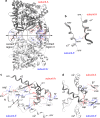Dissociative mechanism for irreversible thermal denaturation of oligomeric proteins
- PMID: 28510015
- PMCID: PMC5418479
- DOI: 10.1007/s12551-016-0220-z
Dissociative mechanism for irreversible thermal denaturation of oligomeric proteins
Abstract
Protein stability is a fundamental characteristic essential for understanding conformational transformations of the proteins in the cell. When using protein preparations in biotechnology and biomedicine, the problem of protein stability is of great importance. The kinetics of denaturation of oligomeric proteins may have characteristic properties determined by the quaternary structure. The kinetic schemes of denaturation can include the multiple stages of conformational transitions in the protein oligomer and stages of reversible dissociation of the oligomer. In this case, the shape of the kinetic curve of denaturation or the shape of the melting curve registered by differential scanning calorimetry can vary with varying the protein concentration. The experimental data illustrating dissociative mechanism for irreversible thermal denaturation of oligomeric proteins have been summarized in the present review. The use of test systems based on thermal aggregation of oligomeric proteins for screening of agents possessing anti-aggregation activity is discussed.
Keywords: Conformational lock; Dissociative mechanism; Oligomeric proteins; Protein denaturation.
Conflict of interest statement
Conflict of interest
The authors declare no conflicts of interest.
Ethical approval
This article does not contain any studies with human participants or animals performed by any of the authors.
Figures





Similar articles
-
Stability of multi-subunit proteins and conformational lock.Prog Biophys Mol Biol. 2020 Jan;150:145-152. doi: 10.1016/j.pbiomolbio.2019.08.008. Epub 2019 Aug 27. Prog Biophys Mol Biol. 2020. PMID: 31470027 Review.
-
Dissociative thermal inactivation, stability, and activity of oligomeric enzymes.Biochemistry (Mosc). 1998 Mar;63(3):303-11. Biochemistry (Mosc). 1998. PMID: 9526127 Review.
-
Irreversible denaturation of maltodextrin glucosidase studied by differential scanning calorimetry, circular dichroism, and turbidity measurements.PLoS One. 2014 Dec 30;9(12):e115877. doi: 10.1371/journal.pone.0115877. eCollection 2014. PLoS One. 2014. PMID: 25548918 Free PMC article.
-
Thermal denaturation and aggregation of hemoglobin of Glossoscolex paulistus in acid and neutral media.Int J Biol Macromol. 2013 Mar;54:109-18. doi: 10.1016/j.ijbiomac.2012.11.022. Epub 2012 Nov 26. Int J Biol Macromol. 2013. PMID: 23194839
-
The kinetic stability of cytochrome C oxidase: effect of bound phospholipid and dimerization.Biophys J. 2014 Dec 16;107(12):2941-2949. doi: 10.1016/j.bpj.2014.10.055. Biophys J. 2014. PMID: 25517159 Free PMC article.
Cited by
-
Dual-Family Peptidylprolyl Isomerases (Immunophilins) of Select Monocellular Organisms.Biomolecules. 2018 Nov 15;8(4):148. doi: 10.3390/biom8040148. Biomolecules. 2018. PMID: 30445770 Free PMC article. Review.
-
A review and summary of the contents of biophysical reviews volume 8, 2016.Biophys Rev. 2017 Feb;9(1):1-4. doi: 10.1007/s12551-017-0249-7. Epub 2017 Feb 7. Biophys Rev. 2017. PMID: 28510044 Free PMC article. No abstract available.
-
A thermal after-effect of UV irradiation of muscle glycogen phosphorylase b.PLoS One. 2017 Dec 7;12(12):e0189125. doi: 10.1371/journal.pone.0189125. eCollection 2017. PLoS One. 2017. PMID: 29216272 Free PMC article.
-
Concentration- and pH-Dependent Oligomerization of the Thrombin-Derived C-Terminal Peptide TCP-25.Biomolecules. 2020 Nov 19;10(11):1572. doi: 10.3390/biom10111572. Biomolecules. 2020. PMID: 33228042 Free PMC article.
-
Foreword to 'Quantitative and analytical relations in biochemistry'-a special issue in honour of Donald J. Winzor's 80th birthday.Biophys Rev. 2016 Dec;8(4):269-277. doi: 10.1007/s12551-016-0227-5. Epub 2016 Nov 4. Biophys Rev. 2016. PMID: 28510020 Free PMC article. Review.
References
-
- Amani M, Moosavi-Movahedi AA, Floris G, Longu S, Mura A, Moosavi-Nejad SZ, Saboury AA, Ahmad F. Comparative study of the conformational lock, dissociative thermal inactivation and stability of euphorbia latex and lentil seedling amine oxidases. Protein J. 2005;24:183–191. doi: 10.1007/s10930-005-7842-5. - DOI - PubMed
-
- Atyaksheva LF, Pilipenko OS, Chukhrai ES, Poltorak OM. Similarity of and differences between the mechanisms of thermal inactivation of β-galactosidases of different origins. Russ J Phys Chem A. 2008;82:864–869. doi: 10.1134/S0036024408050300. - DOI
-
- Atyaksheva LF, Tarasevich BN, Chukhrai ES, Poltorak OM. Thermal inactivation of alkali phosphatases under various conditions. Russ J Phys Chem A. 2009;83:318–323. doi: 10.1134/S0036024409020307. - DOI
Publication types
LinkOut - more resources
Full Text Sources
Other Literature Sources

